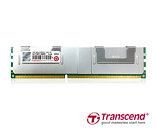Friday, March 8th 2013

Transcend Announces 32GB DDR3 Load-Reduced DIMMs
Transcend Information, Inc., a worldwide leader in storage and multimedia products, today announced the arrival of its 32GB DDR3 Load-Reduced DIMM (LRDIMM) memory module. An important component of today's powerful servers, LRDIMMs use a specially designed buffer to minimize the load on the server memory bus, allowing administrators to maximize memory capacity, increase performance, and reduce the power consumption of their systems.
In standard RDIMM technology, the data bus connects directly to the multiple ranks of DRAM chips on the module, which increases electrical load and limits system speed as more modules are added. In contrast, Transcend's DDR3 Low Voltage LRDIMMs feature a full memory buffer chip on the module, which acts as a go-between for all signals sent from the host to the DRAM chips, reducing the electrical load on all interfaces. Compared to standard RDIMMs or UDIMMs, a system using Transcend LRDIMMs can support more modules per channel and higher maximum memory capacity without sacrificing speed.Thanks to their support for higher memory densities, Transcend's LRDIMM modules are ideal for use in robust infrastructures that run memory-intensive applications, such as virtualization and cloud computing. In servers based on Intel's Romley platform, Transcend's DDR3-1333 LRDIMMs provide system administrators with the opportunity to maximize capacity and achieve optimal performance. For example, a system configured with two Intel Xeon E5 2600 processors on Intel's S2600CO family of motherboards can populate all 24 memory slots with a 32GB LRDIMM, allowing a maximum capacity of 768GB. This represents a 50 percent increase in installed memory capacity over using RDIMMs (maximum 512GB) and a 500 percent increase over UDIMMs (maximum 128GB).
Backed by a limited lifetime warranty, Transcend memory modules are recognized worldwide for their reliable high quality, outstanding performance, excellent compatibility and stable operation.
Product Details:
In standard RDIMM technology, the data bus connects directly to the multiple ranks of DRAM chips on the module, which increases electrical load and limits system speed as more modules are added. In contrast, Transcend's DDR3 Low Voltage LRDIMMs feature a full memory buffer chip on the module, which acts as a go-between for all signals sent from the host to the DRAM chips, reducing the electrical load on all interfaces. Compared to standard RDIMMs or UDIMMs, a system using Transcend LRDIMMs can support more modules per channel and higher maximum memory capacity without sacrificing speed.Thanks to their support for higher memory densities, Transcend's LRDIMM modules are ideal for use in robust infrastructures that run memory-intensive applications, such as virtualization and cloud computing. In servers based on Intel's Romley platform, Transcend's DDR3-1333 LRDIMMs provide system administrators with the opportunity to maximize capacity and achieve optimal performance. For example, a system configured with two Intel Xeon E5 2600 processors on Intel's S2600CO family of motherboards can populate all 24 memory slots with a 32GB LRDIMM, allowing a maximum capacity of 768GB. This represents a 50 percent increase in installed memory capacity over using RDIMMs (maximum 512GB) and a 500 percent increase over UDIMMs (maximum 128GB).
Backed by a limited lifetime warranty, Transcend memory modules are recognized worldwide for their reliable high quality, outstanding performance, excellent compatibility and stable operation.
Product Details:
- Part Number: TS4GKB72W3P
- Capacity: 32 GB
- Description: 1333 MHz DDR3L LRDIMM
- Special Feature: includes thermal sensor

14 Comments on Transcend Announces 32GB DDR3 Load-Reduced DIMMs
Either way, with this config... that 64bit memory "limitation" starts to become more earthly by the day... :D 16 Exabytes or not...
Special Feature: includes thermal sensor
Wish this was on desktop ram too aand maybe with a led to indicate the temp visually.
but i shecked it out this board wont read dims larger then 8 :(
These are SERVER DIMMs, not desktop PC DIMMs. In servers 1333 MHz. at the moment is the high end of the RAM frequency scale. These special DIMMs are intended to increase the RAM density and system performance while reducing power consumption. I expect if they are priced properly and perform as claimed, they will sell a ton of these to enterprise.
BTW, as discussed in other threads and documented in extensive testing, there is no tangible system performance gains for typical desktop PCs other than APU powered PCs, in using RAM faster than 1600 MHz. For most PC enthusiast 1333 MHz. works fine because RAM at 1333 MHz. on typical desktops is not a system bottleneck. As a result using higher frequency or lower RAM timings does not produce any significant system performance improvement.
If you do a lot of CAD, video, etc. then 1600 MHz. RAM will show a slight gain over 1333 MHz. but it ain't much. With the current low prices on RAM, 1600 MHz. RAM cost about the same as 1333 MHz. in many cases, so just buy whatever makes you happy as it won't change system performance significantly.